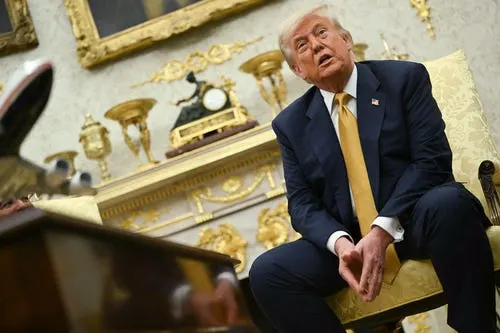When Donald Trump entered the White House in January 2017, he didn’t just bring a new political agenda—he also brought a very distinctive sense of style. From golden drapes to glittering chandeliers, Trump’s personal aesthetic has left a bold imprint on the traditional interiors of the White House. In his own words, “I picked it all myself.”
This statement alone stirred conversation. Many past presidents entrusted seasoned interior decorators or preservation committees to manage subtle updates to the iconic residence. But Trump’s approach was different—more direct, more opulent, and unmistakably Trump.
Let’s explore how Trump White House décor has redefined the aesthetics of the historic building and why it continues to spark conversation, admiration, and criticism alike.
The Trump Touch: Bold, Lavish, and Gold-Lined
From his real estate properties to his private jet, Trump’s style has always leaned toward opulence. Gold finishes, oversized furniture, classical columns, and luxurious materials are trademarks of his aesthetic. It was no surprise, then, that he brought the same flavor to 1600 Pennsylvania Avenue.
One of the first visual changes during his presidency was the replacement of the Obama-era crimson drapes in the Oval Office with gold ones. Trump claimed he made the decision himself, choosing curtains that better matched his vision of presidential strength and elegance.
In interviews, he said, “I picked it all myself.” For critics, it signaled ego. For supporters, it reflected confidence and leadership. Either way, it was clear: Trump White House décor was going to be different.
Historical Preservation vs. Personal Style
The White House is not just a home or office. It’s a museum—a place of heritage with a long-standing tradition of careful restoration and respect for historical elements. The White House Curator’s Office, along with the Committee for the Preservation of the White House, typically manages renovations.
However, Trump chose to bypass some of these conventions. He worked directly with selected designers and reportedly approved changes personally, even on minor details.
While some updates stayed within traditional parameters, others raised eyebrows:
- Gold-accented furniture appeared in multiple rooms.
- New art and sculptures replaced some historically significant pieces.
- The Lincoln Bedroom received new upholstery with richer tones.
- The Blue Room, traditionally subtle in design, was touched up with more vibrant golds and blues.
These choices prompted a broader debate: Should a sitting president be allowed to change the White House so freely?
Comparing with Past Presidents
It’s common for presidents to personalize the White House. John F. Kennedy invited French designers to update the interiors. Obama brought in modern, minimalist aesthetics. The Bush family added Texas charm and warmth.
But Trump’s changes were particularly assertive.
Here’s a quick comparison of decorative styles across administrations:
| President | Style Adopted | Public Reaction |
|---|---|---|
| John F. Kennedy | French-inspired elegance | Praised for sophistication |
| George W. Bush | Southern comfort and class | Subtle and respectful |
| Barack Obama | Modern minimalism | Admired for blending old and new |
| Donald Trump | Gold, grandeur, luxury | Divisive – praised and criticized |
What sets Trump White House décor apart is how bold and unapologetic it is. Rather than making quiet enhancements, Trump’s changes demanded attention.
Key Design Changes Made by Trump
1. Oval Office Overhaul
The most famous room in the West Wing saw some of the most visible changes. Trump’s version featured:
- Gold curtains (replacing Obama’s red ones)
- A redecorated Resolute Desk area with new carpet and furniture
- Framed portraits of Andrew Jackson and Ronald Reagan
2. The Roosevelt Room
Trump replaced traditional artwork with more symbolic pieces. One key change included the removal of a bust of Winston Churchill (which had previously been restored by Obama).
Instead, he displayed items and images that resonated with American industry and strength.
3. Private Dining Room
This room saw one of the most dramatic transformations. The gray, modernist look under Obama was replaced with:
- Deep-colored wood panels
- Gold-trimmed furniture
- Brighter lighting and heavy drapery
These updates made the room look more like one of Trump’s hotels than a historic American residence.
4. Bedrooms and Private Quarters
Reports indicate that Trump customized bedrooms and private areas extensively, though few official images were released. Sources say he preferred rich fabrics, elaborate headboards, and classical motifs.
Mixed Reactions: Admiration and Outrage
As with most things Trump, the reaction to his décor choices was split.
Supporters Say:
- “It’s bold and presidential.”
- “He made the White House look like a palace—finally some class.”
- “Trump’s aesthetic shows strength and leadership.”
Critics Argue:
- “It looks like a luxury hotel, not the people’s house.”
- “Historical integrity was sacrificed for ego.”
- “Too much gold—tacky, not tasteful.”
For some Americans, the issue went deeper than just interior design. It became a symbol of how Trump viewed the presidency—as something to be controlled, personalized, and dominated.
Cultural Impact of Trump’s Décor
What started as a few décor changes has become part of the broader cultural memory of the Trump presidency. Memes, think pieces, and even fashion collections have been inspired by the aesthetic he brought to Washington.
The term “Trump White House décor” is now synonymous with luxury, ego, and disruption of tradition.
Some interior designers saw it as a cultural reset, ushering in a new era where boldness took precedence over subtlety. Others feared it might set a precedent for future leaders to disregard history.
Regardless, Trump’s touch will be remembered.
Legacy of Trump White House Décor

Whether you loved it or hated it, Trump White House décor changed the conversation. It asked Americans to consider what the White House should represent: tradition or transformation, preservation or personalization.
Presidents will come and go. But what they leave behind—physically and symbolically—shapes how history remembers them.
Trump may no longer occupy the White House, but his stylistic legacy continues to echo through its halls.
Final Thoughts: A Bold Redefinition or Just Redecorating?
Trump once said, “I picked it all myself,” and perhaps that quote best captures the heart of this story. It wasn’t just about curtains, chandeliers, or color schemes. It was about power, identity, and how one man saw the seat of American leadership—not as a relic of the past, but as a canvas for personal expression.
As discussions around White House design continue, Trump’s influence will remain a talking point for years to come.
Read Next – EPA Research Office Layoffs: A Blow to Science and Environment






